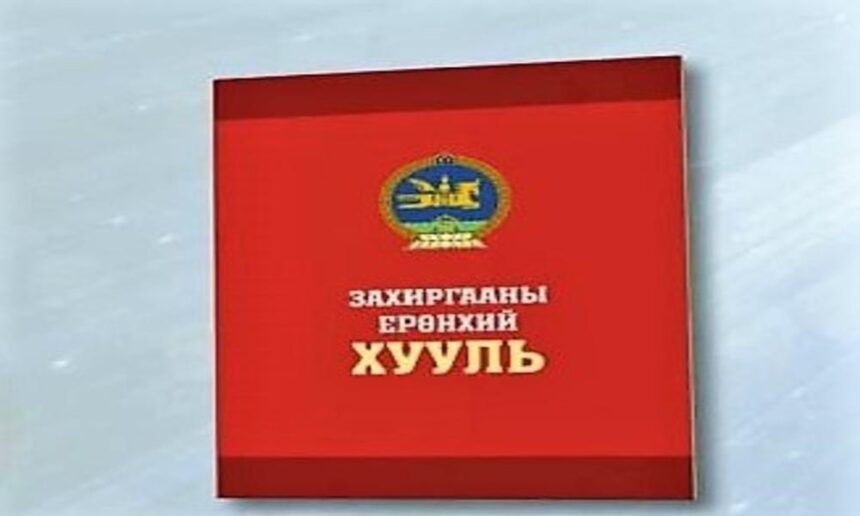In 2002, the Mongolian Parliament adopted two new laws to create a new type of court specialising in administrative law. The new administrative courts became operational in June 2004. In Spring the following year, the Tsets, the body responsible for constitutional control in Mongolia (үндсэн хуулийн цэц; undsen khuuliin tsets; or “Tsets”) issued an opinion (No. 2; 2005) that the administrative courts did not have the power of judicial review—that is, the power to rule on the legality of administrative acts by the Cabinet. As a result, Parliament removed those provisions from the law and the administrative courts were no longer able to address citizens’ complaints against Cabinet decisions. The decision of the Tsets was criticized heavily by lawyers, especially by Professor B. Chimid.
Later, in 2015 and 2016, Parliament adopted the General Administrative Law and the new Law on Administrative Court Procedure. These laws have been in force since July 2016. The administrative courts and the Supreme Court of Mongolia represents the view that these laws reinstated the powers of judicial review by the administrative courts. The administrative courts have accepted, hence, lawsuits against the Cabinet since July 2016. Over the last two years, the administrative courts have reviewed around twenty decisions of the Cabinet, according to one report. The administrative courts have taken up a number of highly politicized issues, such as the 49% of shares of “Erdenet” mining or the Winter/Spring horse races.
Tensions between the Tsets and the Supreme Court
Yet despite the new laws, the Tsets continues to assert its 2005 No. 2 Opinion. In a letter dated 02 April 2018, Mr. D. Odbayar, Chairman of the Tsets, demanded that the Supreme Court correct the “wrong practice of judicial review of Government’s decisions by administrative courts”. In May, the Supreme Court responded, stating that it “refuses to satisfy the demand” put forth by Chairman Odbayar (Defacto Gazette No. 47).
Mr. Odbayar’s letter was criticized by lawyers such as Dr. O. Munkhsaikhan who argued that the Tsetsmay only act if a petition was lodged. Therefore, the Chairman of the Tsets violated both the Constitution and the Constitutional Procedural Law when he issued an opinion without due procedure.
In an October 2018 interview, Supreme Court Justice Dr. G. Banzragch stated that the Tsets’ 2005 No. 2 Opinion was not applicable to the new 2015/2016 laws anyway because the original 2002 Law on Administrative Court Procedure had been repealed by Parliament.
In fact, despite the Tsets’ 2005 No. 2 Opinion, Cabinet decisions were being reviewed—but by the civil courts. Between 2005 and 2016, the civil courts were restoring personal and property rights of individuals if they were violated by Cabinet’s decisions.
The role of the administrative courts
In theory, the administrative courts are in a better position to protect the rights of individuals with regard to state authorities due to the inquisitorial system that originates from German administrative court rules. The administrative courts may actively be involved in investigating the facts of the case, whereas the civil courts are limited primarily to the role of an impartial referee between the disputing parties. Potentially, the rights of citizens could be protected from arbitrary state actions more effectively if the administrative courts were able to clearly carve out their place in the Mongolian judicial system.
Experience shows, however, that the administrative courts’ rules make access to justice more difficult when it comes to areas such as intellectual property protection (Defacto Gazette No. 69). Another issue is whether the administrative courts are capable of distancing themselves enough from politics. For example, the current Law on Administrative Court Procedure permits “organisations representing the public’s interest” as claimants. With the Winter/Spring horse racing case, the administrative courts accepted several children’s’ rights NGOs as claimants. For administrative courts, the risk of becoming of an extended arm of politicians is thus very high.
One other issue involves the courts’ power to interpret ordinary law in consideration of the Constitution of Mongolia. If a regular court considers a law—the validity of which is material to its decision—to be unconstitutional, it should suspend the proceedings and refer the matter to the Supreme Court. The Supreme Court should then ask the Tsets for an opinion if it decides that the referral by the regular court on a law’s constitutionality was sufficiently reasoned.
In the case of the 2015 and 2016 laws, the regular courts did not question the constitutionality despite the existence of the Tsets’ 2005 No. 2 Opinion. The constitutionality of the administrative courts’ actions is therefore questionable as the Tsets is entrusted with safeguarding the constitutionality of the ordinary laws, according to the Constitution of 1992. As discussed in a previous column, this issue reflects the need for reforms of the constitutional procedural law in order to ensure a clear positioning of the Tsets within the Mongolian judicial system.
The way forward
Curbing the administrative courts’ powers of judicial review does not solve the current tensions between the highest constitutional institutions of Mongolia. Instead, procedural rules need to be reformed in order to ensure sufficient distancing of the administrative courts and the Tsets from day-to-day politics. This goal can be achieved only by clearly positioning the Tsets within the judicial system and by limiting the rules regarding the admittance of claims before the administrative courts. Mongolia’s democracy depends on a judiciary that is free from political influence, clearly structured, and thus able to execute its primary role of maintaining law and order in society.
November 2018












